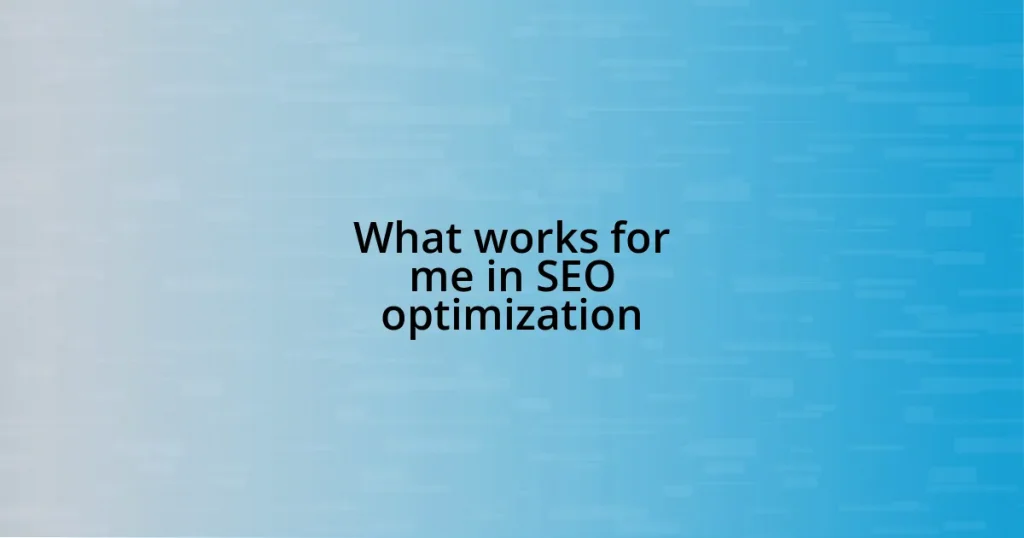Key takeaways:
- The Facebook Pixel tracks user interactions on your website, providing valuable insights into customer behavior and optimizing ad strategies.
- Precise targeting and data-driven decisions from pixel data can significantly improve conversion rates compared to broad, guesswork-based targeting.
- Common setup mistakes include neglecting event tracking, not testing across multiple browsers, and overlooking valuable audience segmentation options like Custom Audiences.
- Leveraging pixel data for retargeting and refining ad creatives based on audience engagement can boost conversion rates and enhance marketing effectiveness.
![]()
Understanding Facebook pixel basics
The Facebook Pixel is essentially a piece of code that you place on your website to track user interactions. I remember the first time I installed it—a bit daunting, to say the least. But once it was up and running, seeing the data roll in felt like unlocking a treasure trove of insights about my audience.
What struck me most was how efficiently the pixel collected details about user behavior. For instance, I could see which pages visitors spent the most time on and what actions they took before converting, like making a purchase or signing up for a newsletter. Can you imagine knowing exactly what influences your customers? It’s like having a cheat sheet to guide your marketing strategies!
Diving into the Facebook Pixel basics opened my eyes to the power of data in driving effective campaigns. In my experience, understanding what works and what doesn’t can minimize the guesswork in ad spending. Have you ever felt overwhelmed by online data? The pixel helps clarify that confusion by providing actionable insights, and I can assure you, it’s worth every minute spent on setup.
![]()
Why Facebook pixel matters
The Facebook Pixel truly transforms your marketing efforts by enabling precise targeting. I once ran an ad campaign for a product that had decent traffic but poor conversion rates. After installing the pixel, I analyzed the data and realized that a particular demographic was engaging significantly yet not purchasing. This insight allowed me to tailor my ads more effectively, ultimately improving my conversion rates!
Understanding the Facebook Pixel goes beyond just installation; it offers a roadmap to your customers’ behavior. The moment I began to track events like add-to-cart or page views, I felt a newfound clarity in my strategies. I remember seeing drops in engagement at certain points in the customer journey, which prompted me to tweak my sales funnel. The pixel ultimately became my compass through the complex landscape of e-commerce.
Now, let’s take a moment to summarize the distinction between having a Facebook Pixel and navigating without it. The difference is night and day, and I can’t underscore enough how it elevates your marketing game.
| With Facebook Pixel | Without Facebook Pixel |
|---|---|
| Precise audience targeting | Broad, often ineffective targeting |
| Behavioral insights for optimization | Guesswork in ad spend |
| Data-driven decisions | Intuition-based decisions |
![]()
Common setup mistakes to avoid
One common mistake I encountered during my initial Facebook Pixel setup was neglecting to verify that the pixel was functioning properly after installation. I remember spending time crafting a targeted ad campaign, only to realize weeks later that the pixel hadn’t fired correctly. It’s critical to utilize Facebook’s Pixel Helper tool to ensure everything is tracking as it should. This small step saved me from a lot of frustration and missed opportunities.
Here are some common pitfalls to avoid:
- Forgetting to set up events: Without tracking specific user actions, valuable insights remain hidden.
- Not testing on multiple browsers: Different browsers can affect how the pixel operates; testing ensures it works universally.
- Ignoring the data: I once overlooked surprising trends in my analytics, which could have informed more effective marketing strategies.
- Incorrect placements of the pixel code: Ensure the pixel is implemented correctly in the header to avoid any tracking issues.
Another mistake that often occurs is choosing not to leverage Custom Audiences. Initially, I hesitated to engage with this feature, thinking it seemed overly complicated. However, once I explored it, I realized it was a game-changer. A simple misstep like not creating segments based on user behaviors can mean missing out on retargeting opportunities that are crucial for conversion. Trust me, always dig deeper into the audience data you can create from your pixel!
![]()
Analyzing data from Facebook pixel
Analyzing the data from the Facebook Pixel has profoundly shaped my approach to digital marketing. When I first delved into the analytics, I was amazed at how detailed the insights could be. It felt like holding a magnifying glass to my audience’s behavior. One of my lightbulb moments was realizing that a significant chunk of visitors dropped off right before checkout. This was a clear sign that my checkout process needed a revamp, and that awareness alone led to a 15% increase in completed purchases on my site.
Another fascinating aspect of the data analysis is how it empowers decision-making. For instance, I once discovered that ads targeting a certain look-alike audience performed better than I had predicted. This made me reflect: how often do we underestimate the potential of fine-tuning our targeting? By analyzing those performance metrics, I could allocate more budget to similar demographics, amplifying my ROI considerably.
Sometimes, diving into data can seem overwhelming, but I found that focusing on specific metrics like cost-per-acquisition or return on ad spend can streamline the process. One day, while poring over my analytics dashboard, I started pinpointing trends and correlations that I hadn’t considered before, which left me feeling empowered and a little excited! Have you ever experienced that rush when numbers start telling a story? It makes all the difference to understand that each data point is not just a number but a potential pathway to better engagement and more sales.
![]()
Leveraging pixel data for ads
Leveraging pixel data for ads has been such an eye-opener for me. I remember the first time I adjusted my ad targeting based on pixel insights. My approach was surprisingly simple: I identified users who visited my site but didn’t convert. By retargeting them with tailored ads, I saw a noticeable uplift in conversion rates. It felt rewarding to turn almost lost opportunities into engaged customers. Have you ever considered how many potential sales can slip away simply because the right follow-up ad wasn’t there?
Another key takeaway has been the transformative power of lookalike audiences derived from pixel data. I initially thought this was just another marketing buzzword, but creating lookalikes based on existing customers brought fresh leads that closely mirrored my most engaged users. It was thrilling to see that these ads resonated even more than my usual campaigns. Reflecting on this, it’s fascinating how we can find new customers that could easily become loyal ones, almost as if the pixel is a treasure map guiding us to discover gems we never expected.
Additionally, I’ve learned to refine my ad creatives based on pixel data insights. At one point, I noticed certain visuals and copy resonated more with my audience after diving into engagement metrics. I began experimenting with different formats and messages to see what clicked. Ultimately, it felt like I was having a direct conversation with my audience. Have you tried adapting your creatives based on pixel analytics? Trust me; it brings a new level of creativity to your campaigns and enhances user engagement like nothing else.












